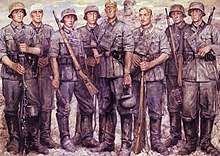Wilhelm Sauter
Wilhelm Sauter (born April 1, 1896 in Bruchsal, died June 27, 1948 in Göppingen) was a German painter, especially known for his war paintings.
Wilhelm Sauter | |
|---|---|
| Born | April 1, 1896 Bruchsal, Germany |
| Died | June 27, 1948 (aged 52) Göppingen, Germany |
| Nationality | German |
| Awards | Gaukulturpreis 1939 |
| Patron(s) | Adolf Hitler |
After his graduation from school he went to Heidelberg in 1913 in order to become a schoolteacher for art education.
After outbreak of World War I he became a soldier in the German Infantry Regiment No. 169 in Lahr in 1915. One year later, he was deployed at the Somme near Serre. He was buried alive by an exploding artillery shell and partially lost his sense of hearing. His war experiences later became the basis for his most famous works.
After a stay in the military hospital, he got employed at the Volksschule (elementary school) in Bruchsal. From 1918 to 1920 he studied at the Badische Landeskunstschule (Baden School of Arts) in Karlsruhe.
Among his professors were Karl Eyth, August Groh, Walter Conz and Friedrich Fehr. After his graduation he was a schoolteacher in Villingen, Bruchsal, Karlsruhe, Weinheim and Ladenburg. At the instigation of Hans Thoma there was the first exhibition of Sauter's works at the Karlsruher Kunstverein (Karlsruhe Art Club).
In the 1920s Wilhelm Sauter got married. One of his sons died of diphtheria when he was 14 years old.
Wilhelm Sauter created a lot of portraits, pieces of landscape art and pictures of soldiers in different situations. He used the technique of painting as well as drawing and etching. Between 1924 and 1927 he created six drypoint illustrations to Grimmelshausen's novel Simplicius Simplicissimus.
Especially his war paintings attracted the attention of the Nazis. His pictures were shown at different exhibitions, e.g. at the exhibition Heroische Kunst (Heroic Art) in Berlin in 1935,[1] at the Badische Gaukulturschau (Baden District Culture Exhibition) in 1937, several times at the Große Deutsche Kunstausstellung (Great German Art Exhibition) in the Haus der Deutschen Kunst in Munich or at the Venice Biennale in 1942. His war paintings of this time are less dismal but more heroic than his former works.
The Badisches Armeemuseum (Baden Military Museum) in Karlsruhe purchased some of Sauters works, as well as Adolf Hitler and Fritz Todt.[1]
In 1939 Wilhelm Sauter was awarded the Gaukulturpreis (District Culture Award).[1]
In 1941 he was appointed to a professor at the Hochschule der bildenden Künste (Academy of Fine Arts, Karlsruhe) in Karlsruhe,[1] which was the former Badische Landeskunstschule where he had studied. He worked there until 1945.[2]
Works

- Totentanz (Danse macabre) (1917–1918)
- Grabenposten im Feuer (Trench Post under Fire) (1928)
- Essenholer (Food Porter) (1931)
- Im Laufgraben (In the Communication Trench) (1932)
- Endlose Straße (Endless Street) (1934)
- Der gute Kamerad (The Good Comrade) (1934)
- Wassertrinker (Water Drinkers) (1936)
- Der Bauernführer Joß Fritz (The Peasant Leader Joss Fritz) (1937)
- Kampfzeit (Time of Fight) (1937)
- Die Badischen Grenadiere in der Schlacht bei Cambrai (The Baden Grenadiers in the Battle of Cambrai) (1938)
- Zwei Wege (Two Ways) (1939)
- Der ewige Musketier (The Eternal Soldier) (1940)[3]
- Vormarsch im Westen (Advance in the West) (1941)
- Westfront 1940 (Western Front 1940) (1941) (former property of Adolf Hitler, now being housed at the U.S. Army Center of Military History at Fort Belvoir[4])
- Serre (Somme) 1916 (ca. 1942)
- Übergang am Oberrhein (Crossing the Upper Rhine) (1942)[5]
- Verschüttet (Buried Alive)
- Begegnung (Encounter)
- Das Kreuz von Serre (The Cross of Serre)
- Der ewige Musketier (The Eternal Soldier)
- l.M.G. (light Machine Gun)[6]
- Stoßtrupp (Stormtroopers)
- Ums Morgengrauen (At Sunrise)
- Der tote Kamerad (The Dead Comrade)
- Melder (Despatch Runner)
- Das Opfer (The Sacrifice) (destroyed during an air raid in 1942)
- Frontsoldat (Front Soldier)
References
- Schwarzmaier, Hansmartin and Schaab, Meinrad: Handbuch der baden-württembergischen Geschichte, Band 4: Die Länder seit 1918(Compendium of Baden-Wuerttemberg History, Vol. 4: The provinces since 1918), Klett-Cotta, Stuttgart 2003, ISBN 3-608-91468-4, p. 214
- Register of former professors at the State Academy of Fine Arts in Karlsruhe
- Exhibition Catalogue 1940 from the Haus der Deutschen Kunst in Munich
- The Washington Post via Getty Images
- Postcards from the Haus der Deutschen Kunst in Munich
- Postcards from the Haus der Deutschen Kunst in Munich
Further reading
- Wilkendorf, Fritz: Der Kriegsmaler Wilhelm Sauter (The war painter Wilhelm Sauter), in: Ekkhart - Jahrbuch für den Oberrhein (Ekkhart – Almanac for the Upper Rhine area), Volume 24, G. Braun Publishing, Karlsruhe 1943, p. 26–37
External links
- Nazi War Art 1940-44 Small gallery that includes The Eternal Soldier
- Haus der Deutschen Kunst, Munich, Part 3 Gallery of war paintings from Haus der Kunst which includes Crossing the Upper Rhine
- West Front 1940 in the Army Art Collection, US Army Center of Military History, Museum Support Center